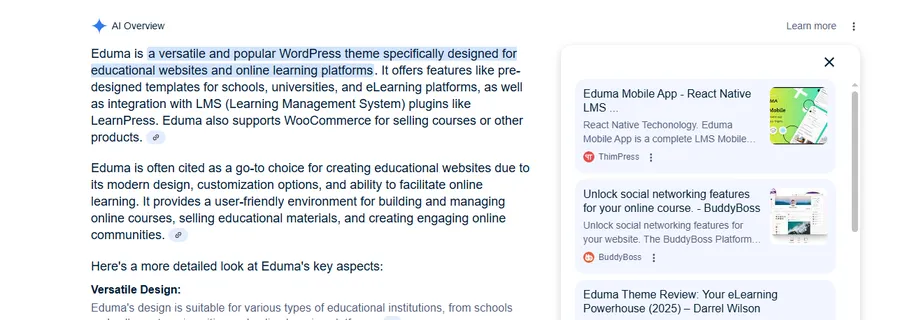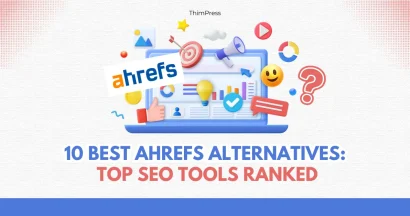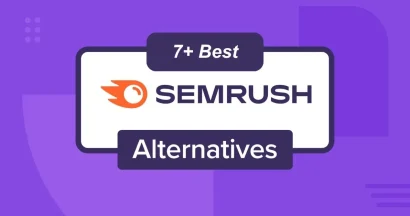Have you noticed that Google now gives AI-powered summaries right at the top of search results? Those short answers, called Google AI Overviews, are reshaping how websites appear on Google.
Instead of showing only traditional blue links, Google’s AI now creates quick, clear summaries using trusted sources from across the web. That means your site could appear inside those summaries — or get pushed further down if it’s not optimized.
In this article, we’ll explain what Google AI Overviews are, how they impact SEO, and practical ways to help your content rank within these AI-driven results. By the end, you’ll know how to adapt your SEO strategy for the new AI search era.
Eduma – Education WordPress Theme
We provide an amazing WordPress theme with fast and responsive designs. Let’s find out!
What are Google AI Overviews?
Google AI Overviews are AI-generated summaries that appear at the top of Google’s search results. They are designed to give users quick, clear answers to their questions without requiring them to visit multiple pages.
The system gathers and synthesizes information from reliable websites and presents it in short paragraphs, bullet points, or visual elements. Links to the source websites usually appear below or beside the summary, giving users the option to learn more.
This feature — part of Google’s Search Generative Experience (SGE) — significantly changes how people interact with search results. Since AI Overviews often take the top position, traditional organic results can be pushed further down the page.
To stay ahead, consider these best free Google SEO tools that can help monitor and improve your site’s visibility.
Why Appearing in Google AI Overviews Matters
Earning a position in a Google AI Overview can deliver multiple benefits:
- Prime Visibility: Your content appears above standard organic results — a highly visible and clickable area.
- Higher Authority: Being featured by Google’s AI signals that your content is trustworthy and authoritative.
- Potential Traffic Growth: While some users find answers directly from the overview, many still click the linked sources for more detail.
- Competitive Advantage: Businesses optimizing early for AI Overviews will outpace competitors still relying on old ranking methods.
Tip: Use SEO analytics tools like Semrush or Ahrefs to check whether your pages are being cited in AI-generated results and which keywords trigger them.
The Significance of Appearing in an AI Overview Google

Securing a spot in a Google AI overview means gaining prime visibility at the very top of the search results. This prominent placement can lead to several benefits:
- Increased Brand Authority: Being featured as a source in an AI-generated answer can enhance a brand’s perceived authority and trustworthiness on a given topic.
- Potential Traffic Boost: While the overview itself might answer the user’s query, the source links still offer an opportunity for click-throughs from users seeking more detailed information.
- Competitive Edge: As Google AI Overviews become more common, businesses that successfully optimize for them will likely gain an advantage over competitors who do not.
The evolving nature of search necessitates a proactive approach. Adapting content strategies to align with the way an AI overview is generated is critical for future SEO success.
5+ Strategies to Rank in Google AI Overviews
Optimizing for Google AI Overviews requires a nuanced approach that prioritizes user intent and high-quality, well-structured content. Learn how to craft content that meets SEO standards and adds genuine value to your audience. Semrush’s AI SEO Toolkit can support this process by measuring how often your brand appears in AI-generated answers, analyzing sentiment, and revealing topic associations that AI systems connect with your content. The toolkit also benchmarks competitors and surfaces real user questions asked to AI, helping refine content strategies for higher visibility. By leveraging these insights, brands can align their optimization efforts with how Google and other AI-driven engines generate overviews. Based on current understanding and best practices, here are key strategies:
1. Focus Heavily on User Intent
Understanding what a user wants when they search is essential. When creating content, keywords and questions must be categorized based on the four main user intent types. Using tools like Google Trends can aid in identifying relevant keywords that align with user intent.
- Informational: The user is seeking information (e.g., “how does photosynthesis work?”). Google AI Overviews frequently favor content with informational intent.
- Navigational: The user wants to find a specific website or page (e.g., “Google homepage”).
- Transactional: The user intends to make a purchase or complete an action (e.g., “buy running shoes”).
- Commercial Investigation: The user is comparing products or services before a potential transaction (e.g., “best CRM software for small business”).
Prioritize creating the most comprehensive and clear answer for queries, especially those with informational intent, as these are frequently addressed by an AI overview Google.
2. Craft High-Quality, Structured, and Conversational Content
Generative AI tends to favor content that is well-organized, clear, and answers questions directly. Consider these content characteristics:
- Clear Definitions and Explanations: Provide direct and unambiguous definitions for key terms related to the subject matter.
- Step-by-Step Processes: For “how-to” queries, break down processes into easy-to-follow steps.
- Conversational Language: Write in a natural, conversational tone, mirroring how users ask questions. Avoid overly technical jargon unless defining it clearly.
- Comprehensive Coverage: Explore different facets of a topic, addressing potential follow-up questions a user might have.
- Value Proposition: Clearly articulate the benefits or value of the product, service, or information being discussed. Content that demonstrates direct experience or unique insights (without using personal pronouns) can be particularly effective.
3. Analyze Competitor Content and Industry Language
Examine the content that currently ranks well for target queries, including any existing Google AI Overviews. Identify common themes, structures, and the type of language used. This analysis can reveal opportunities to create more comprehensive or clearer content. Develop a strategy that positions the content as a leading resource by addressing gaps or providing superior explanations.
Content that performs well often:
- Includes direct definitions of the subject.
- Explores various dimensions of a topic.
- Is differentiated by unique insights or comprehensive data.
- Emphasizes the core benefits or solutions offered.
4. Determine and Present Contextual Value
For topics involving processes, products, or services, providing context and measurable breakdowns is beneficial. This includes:
- Measurable Breakdowns: If discussing a process, detail the steps involved and, if applicable, any associated costs or timeframes. For products or services, explain the return on investment (ROI) or other measurable benefits.
- Trackable Metrics: When discussing benefits, explain how they can be tracked and why those metrics add value.
5. Optimize for Specific Content Types
Certain content formats are frequently pulled into Google AI Overviews:
- FAQs: A well-structured FAQ section can directly answer common questions that AI models might look for.
- How-To Guides and Tutorials: Step-by-step instructions are highly valued.
- Detailed Explanations and Definitions: Content that clearly defines terms and explains concepts is often featured.
- Best Practices and Standards: Listing established best practices or industry standards for a particular subject can be advantageous.
Enhance existing content like case studies by incorporating clear definitions and outlining processes in a way that directly answers potential search queries. Additionally, implementing effective internal linking strategies can boost your content’s visibility in search results.
Frequently Asked Questions on Google AI Overviews
1. What triggers a Google AI Overview?
A Google AI Overview is typically triggered when Google's algorithms determine that a concise, AI-generated summary would provide the best and quickest answer to a user's query, especially for informational searches.
2. What is the impact of an ai overview on SEO?
While Google AI Overviews do not directly serve as a traditional ranking factor, they significantly impact SERP visibility and can affect organic click-through rates. Optimizing content to be featured in an AI overview google is becoming a crucial aspect of a comprehensive SEO strategy.
3. Where are the links to source websites found in an AI Overview?
Links to the source content are usually displayed below or to the side of the AI-generated summary. On desktop, these might appear as a carousel of linked cards. On mobile, users might tap on icons or a "show more" option to see the sources.
4. How do Google AI Overviews vary across industries?
The nature and prominence of Google AI Overviews can differ based on industry and query intent. For instance: - In technology or software, overviews might summarize feature comparisons or ROI-driven information. - In manufacturing, they might focus on capabilities or process explanations. - For consumer products, an AI overview could highlight key features, reviews, or comparison points.
The Future of Search: Embracing AI
Google continues to integrate AI more deeply into its search products. The expansion of Google AI Overviews to more users and query types is a clear indicator of this direction. Even paid search is evolving, with AI-powered ad formats appearing in conjunction with relevant queries.
To succeed in this AI-driven search era, mastering conversational search patterns is essential. This involves understanding natural language processing and how users phrase questions when interacting with AI assistants or search engines. Continuous testing of optimization tactics and staying informed about algorithm updates will be key to maintaining strong organic traffic and click-through rates. Adapting to these changes is fundamental for adding value and achieving visibility in a digital world increasingly shaped by artificial intelligence.
Read more:
8 Must-have Digital Marketing Tools for Success
10+ Best Ways to Use Google Trends for SEO (Tested)
7+ Best SEO Audit Tools for Your Website
Contact US | ThimPress:
Website: https://thimpress.com/
Fanpage: https://www.facebook.com/ThimPress
YouTube: https://www.youtube.com/c/ThimPressDesign
Twitter (X): https://twitter.com/thimpress


